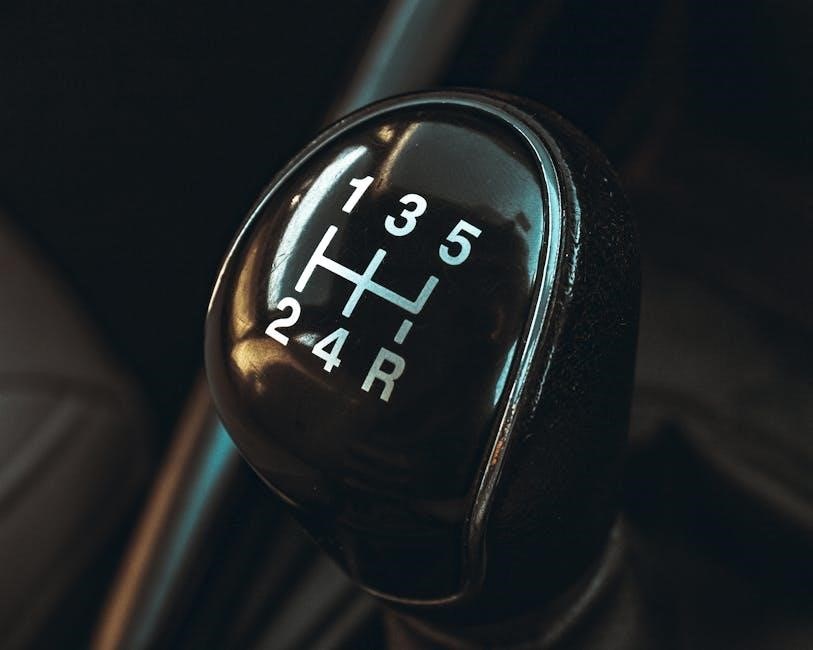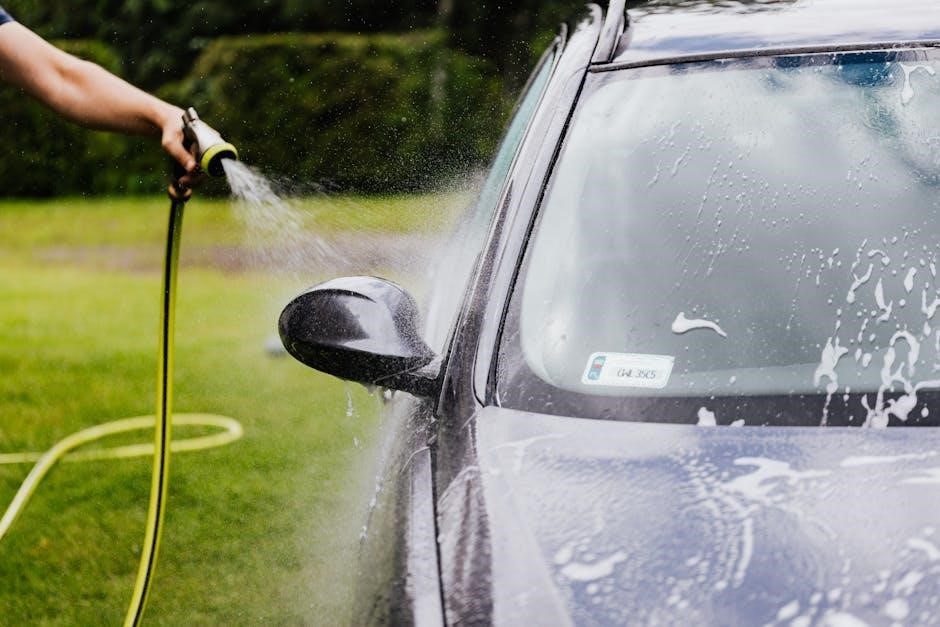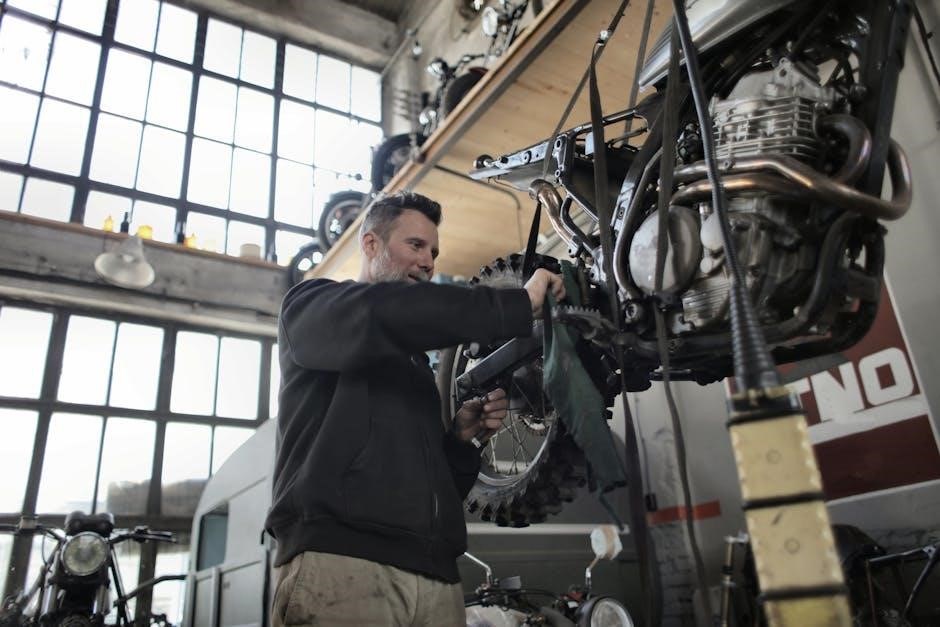Two-post lifts are essential for vehicle maintenance, offering durability and efficiency. Proper installation ensures safety, stability, and optimal performance, making it crucial to follow guidelines carefully.
1.1 Overview of 2 Post Lifts
Two-post lifts are versatile and widely used for vehicle maintenance, offering efficient lifting solutions. Typically designed for indoor use, they consist of two vertical columns, a crossbeam, and lifting arms. These lifts are ideal for garages and workshops due to their space-saving design and high weight capacity. Most models feature a clear-floor design, allowing easy access under vehicles. Hydraulic systems power the lifting mechanism, ensuring smooth operation. Asymmetric arms provide flexibility for various vehicle types, while safety features like automatic locks enhance reliability. Proper installation and maintenance are essential for optimal performance and longevity.
1.2 Importance of Proper Installation
Proper installation of a two-post lift is critical to ensure safety, functionality, and durability. Incorrect installation can lead to structural instability, posing risks to personnel and vehicles. A well-executed setup guarantees the lift operates within its weight capacity and meets safety standards. It also prevents premature wear and tear, reducing maintenance costs. Following manufacturer instructions closely minimizes potential hazards and ensures compliance with industry regulations. A correctly installed lift enhances workshop efficiency, providing reliable service for years. Always prioritize adherence to guidelines for optimal performance and safety.

Safety Precautions and Guidelines
Adhering to safety protocols is vital during installation to prevent accidents and ensure a secure setup. Always follow manufacturer guidelines and use proper protective equipment.
2.1 General Safety Tips

Always review the manual before starting the installation to ensure understanding of all safety measures. Wear personal protective equipment, including gloves and safety glasses. Ensure the area is clear of obstacles and well-ventilated. Verify the floor strength meets the lift’s requirements. Never exceed the lift’s weight capacity. Keep loose clothing and long hair tied back. Avoid working under the lift until it is securely anchored. Follow proper sequencing for assembly to maintain stability. Ensure all bolts and connections are tightened properly. Regularly inspect components for wear or damage. Maintain a clean workspace to prevent slips and trips. Stay alert and focused throughout the process.
2.2 Personal Protective Equipment (PPE)
Wearing appropriate PPE is critical during the installation of a 2-post lift to minimize risks and prevent injuries. Essential items include safety glasses with impact-resistant lenses to protect eyes from debris. Heavy-duty gloves provide grip and safeguard hands from cuts or abrasions. Steel-toe boots are mandatory to prevent foot injuries from falling tools or components. Hearing protection, such as earplugs, should be used when operating power tools. A dust mask may also be necessary when drilling or sawing concrete. Lastly, high-visibility clothing can enhance awareness in busy work environments. Always ensure PPE is worn correctly and consistently throughout the installation process.
2.3 Pre-Installation Safety Checks
Before starting the installation, ensure the area is clear of obstacles and tripping hazards. Verify that the floor meets the required specifications, including thickness and compressive strength, to support the lift’s weight. Inspect all components for damage or defects and ensure they are free from debris. Review the manufacturer’s manual to understand all safety features and requirements. Conduct a final check to ensure all safety devices are functioning properly. Ensure proper ventilation in the workspace and confirm that all power tools are in good working condition. This step is crucial for a safe and successful installation process.

Tools and Materials Required
Essential tools include a drill, wrench, and socket set. Materials needed are concrete, anchor bolts, and hydraulic fluid. Ensure all items are readily available for installation.
3.1 Essential Tools for Installation
The installation process requires specific tools to ensure accuracy and safety. A cordless drill with various drill bits is necessary for concrete drilling. Adjustable wrenches and socket sets are essential for tightening bolts and fittings. A torque wrench is needed to apply the correct tension to bolts, preventing over-tightening. Additionally, a level tool ensures proper alignment of lift columns. Hydraulic fluid and a pump are required for the lift’s operation. Having these tools organized and within reach streamlines the installation, reducing the risk of errors and saving time. Proper tool usage is critical for a successful setup.

3.2 Additional Materials Needed
Beyond the essential tools, several materials are necessary for a successful installation. Concrete anchors and bolts are required to securely fasten the lift to the floor, ensuring stability. Hydraulic fluid is needed to power the lift’s system, and a hydraulic pump may be required depending on the model. Grease or lubricant is essential for moving parts to ensure smooth operation. Additionally, safety materials like jack stands and wheel chocks should be on hand for added security during the process. Having all these materials prepared in advance ensures a smooth and efficient installation. Proper preparation is key to avoiding delays.

Site Preparation and Planning
Ensure the installation area is clear, with proper space for the lift and vehicles. Verify the floor strength and layout to accommodate the lift’s specifications.
4.1 Evaluating the Installation Location
Choosing the right location for your 2-post lift is crucial. Ensure the area is spacious, with at least 13 feet of clearance from doors and obstacles. The floor must be level, made of 4-inch thick concrete with a minimum strength of 3000 psi. Avoid installing near water sources or in areas prone to moisture. Check for proper drainage and ensure the space is well-ventilated. Electrical outlets should be nearby for power supply. Additionally, verify that the location complies with local building codes and regulations. Proper planning ensures safe and efficient lift operation.
4.2 Floor Requirements and Specifications
The floor must be constructed of minimum 4-inch thick concrete with a compressive strength of at least 3000 psi. It should be reinforced with steel for added durability. Ensure the surface is level and free from cracks or unevenness, as this can compromise the lift’s stability. Avoid installing the lift in pits or depressions, and ensure the area is not prone to water accumulation. The floor should also be able to support the combined weight of the lift and the heaviest vehicle it will handle. Proper floor preparation is essential for safe and reliable operation. Always verify these specifications before proceeding.
4.3 Positioning the Lift Correctly
Correct positioning ensures safe operation and optimal use of space. Place the lift at least 13 feet away from any door to allow easy vehicle access. Center the lift in the bay, ensuring equal clearance on both sides. Align the lift columns with the floor anchors, maintaining the manufacturer’s specified distance between them. Use a laser level to ensure the columns are plumb and aligned properly. Proper positioning prevents uneven load distribution and enhances stability. Double-check measurements and alignment before securing the lift to the floor. This step is critical for both functionality and safety. Always refer to the installation manual for specific positioning guidelines.

Step-by-Step Installation Process
The process involves unpacking components, assembling lift columns, attaching arms and accessories, installing the hydraulic system, and anchoring the lift to the floor securely.
5.1 Unpacking and Organizing Components
Begin by carefully unpacking all components from the shipping packages. Ensure no damage occurred during transit. Organize parts according to the inventory list provided in the manual. Separate structural components, hydraulic systems, and accessories into labeled categories. Place smaller parts in designated containers to prevent misplacement. Heavy items, like columns and arms, should be securely positioned for easy access. Refer to the manual for component identification and assembly order; Proper organization ensures a smooth and efficient installation process, minimizing delays and potential errors. Safety and efficiency rely on careful preparation.
5.2 Assembling the Lift Columns
Begin by assembling the lift columns according to the manufacturer’s instructions. Attach the base plates to the floor brackets, ensuring they are level and properly aligned. Secure the columns to the base plates using the provided hardware. Tighten all bolts firmly to maintain structural integrity. Next, install the lift’s upper beam and cross members, ensuring they are securely fastened. Double-check the alignment and levelness of the columns before proceeding. Proper assembly of the lift columns is critical for safety and functionality, so follow the manual carefully to avoid errors.
5.3 Attaching the Arms and Accessories
Attach the lifting arms to the columns, ensuring they are securely fastened with the provided bolts. Connect the hydraulic hoses between the columns, making sure they are properly seated and not twisted. Install any additional accessories, such as arm locks or cable systems, according to the manufacturer’s instructions. Double-check all connections for tightness and alignment. Finally, test the arms and accessories to ensure they function smoothly and safely. Refer to the manual for specific configurations and torque specifications to complete this step accurately. Proper installation of these components is essential for the lift’s performance and reliability.
5.4 Installing the Hydraulic System
Begin by positioning the hydraulic cylinders on each column, ensuring they are aligned correctly. Connect the hydraulic hoses to the cylinders, making sure they are securely fastened with the provided fittings. Route the hoses across the overhead beam and down to the opposite column, avoiding any twists or kinks. Once connected, bleed the hydraulic system to remove air bubbles, which can cause malfunctions. Refer to the manual for specific bleeding procedures and pressure settings. Finally, test the hydraulic system by raising and lowering the lift to ensure smooth operation and proper fluid flow. This step is critical for the lift’s functionality and safety.
5.5 Anchoring the Lift to the Floor
Once the lift columns are assembled and positioned, anchor them securely to the floor using the provided anchor bolts. Locate the pre-drilled holes in the base plates and align them with the floor markings. Drill pilot holes into the concrete floor, then insert the anchor bolts, ensuring they are tightened to the specified torque. Proper anchoring prevents movement and ensures stability during operation. Double-check that all bolts are tightened evenly and meet the manufacturer’s torque specifications. This step is critical for safety and prevents potential shifting or tipping of the lift. Ensure the floor meets the required thickness and strength for secure anchorage.

Testing and Inspection
After installation, perform a thorough safety check, test the hydraulic system, and ensure all arms are aligned properly. Conduct a load test to verify smooth operation.
6.1 Initial Testing of the Lift
After installation, conduct an initial test without a vehicle. Raise and lower the lift several times to ensure smooth operation. Check for any unusual noises or fluid leaks. Verify that all safety mechanisms, such as automatic arm locks, engage properly. Test the lift at various heights to ensure stability and alignment. Refer to the manufacturer’s guidelines for specific testing procedures. If any issues arise, address them before proceeding to load testing with a vehicle. This step ensures the lift functions safely and efficiently.
6.2 Checking Hydraulic and Safety Features
After initial testing, inspect the hydraulic system for leaks or damage. Ensure all hoses and connections are secure and properly routed. Test the safety mechanisms, such as load-holding valves and emergency stops, to confirm they function correctly. Check the hydraulic fluid level and top it off if necessary. Verify that the safety arms lock securely at each designated height. Test the lift under load to ensure smooth operation and reliable safety features. Refer to the manufacturer’s specifications for hydraulic pressure and safety standards. Properly functioning hydraulic and safety systems are critical for safe and efficient lift operation; Always follow the manual’s guidelines.
6.3 Final Inspection and Adjustments
Conduct a thorough inspection of all components, ensuring everything is secure and aligned. Check for any loose bolts or connections and tighten as needed. Verify proper operation of all safety features and hydraulic functions. Make adjustments to leveling pads or arm assemblies for optimal balance. Ensure the lift operates smoothly across its full range of motion. Review the manufacturer’s checklist to confirm all steps are completed. Document any final adjustments and update maintenance records. A meticulous final inspection guarantees reliability and safety, ensuring the lift performs as intended for years to come. Always refer to the manual for specific adjustments.

Maintenance and Upkeep
Regular lubrication of moving parts and thorough cleaning prevent wear and tear. Schedule routine checks to ensure all components function properly, maintaining safety and efficiency.
7.1 Regular Maintenance Schedule
A well-planned maintenance schedule is crucial for extending the life of your 2-post lift. Start by inspecting all hydraulic lines and cylinders monthly for leaks or damage. Lubricate pivot points and moving parts every 1,000 hours of use to ensure smooth operation. Additionally, check the wire ropes for frays or wear and replace them immediately if damage is detected. Schedule a professional inspection annually to identify and address potential issues before they escalate. Regular cleaning of the lift and its components also prevents dust and debris buildup, ensuring optimal performance and safety. Consistency is key to maintaining reliability.
7.2 Lubrication and Cleaning
Proper lubrication and cleaning are vital for maintaining the functionality of your 2-post lift. Apply high-grade lubricant to all moving parts, such as hydraulic cylinders and pivot pins, every 500 hours of use. Regularly wipe down surfaces to remove grease, oil, and debris, which can interfere with smooth operation. Use a mild solvent for tough stains, but avoid harsh chemicals that might damage components. Inspect for wear during cleaning and address any issues promptly. A clean and well-lubricated lift ensures longevity, safety, and optimal performance, preventing premature wear and potential malfunctions. Consistent attention to these details is essential.
7.3 Replacing Wearable Parts
Regularly inspect and replace wearable parts, such as hydraulic hoses, cylinders, and safety latches, to ensure optimal performance and safety. Refer to the manufacturer’s manual for specific part numbers and torque specifications. Replace hydraulic hoses if cracks or leaks are detected, and check cylinders for damage or corrosion. Safety latches should be replaced immediately if they show signs of wear. Always use genuine replacement parts to maintain the lift’s integrity. Proper installation of new parts is crucial to prevent future malfunctions. Neglecting to replace worn components can lead to operational failures, emphasizing the importance of routine inspections and timely replacements.

Troubleshooting Common Issues
Common issues include hydraulic leaks, uneven lifting, and arm misalignment. Address these by inspecting hoses, checking balance, and adjusting arms. Always refer to the manual.
8.1 Identifying and Diagnosing Problems
Identifying issues early ensures safety and prevents further damage. Start by inspecting hydraulic systems for leaks or blockages. Check for uneven lifting, which may indicate imbalance or misaligned arms. Listen for unusual noises, as they often signal worn parts or improper installation. Use diagnostic tools to test hydraulic pressure and electrical connections. Always consult the manual for specific troubleshooting steps. Regular maintenance can help detect potential issues before they escalate. Addressing problems promptly ensures the lift operates safely and efficiently, adhering to manufacturer guidelines.
8.2 Resolving Hydraulic Malfunctions
Hydraulic issues are common but must be addressed promptly to prevent damage. Start by inspecting hoses and cylinders for leaks or blockages. Replace worn seals or O-rings, and ensure fluid levels are adequate. Air in the system can cause malfunctions; bleed the lines carefully. If the lift doesn’t rise smoothly, check for obstructions or incorrect fluid viscosity. Always refer to the manufacturer’s manual for specific repair steps. Testing the system after repairs is crucial to ensure proper function. Regular maintenance can help prevent future hydraulic problems, ensuring safe and reliable operation.
8.3 Addressing Alignment and Balance Issues
Alignment and balance issues can affect the lift’s performance and safety. Start by ensuring the columns are level and securely anchored. Check the arm alignment and adjust if necessary to prevent uneven lifting. If the lift tilts or wobbles, inspect the floor for unevenness and re-anchor the columns if needed. Use a spirit level to verify proper alignment. Lubricate pivot points to ensure smooth operation. If issues persist, consult a professional to avoid safety risks. Proper alignment and balance are critical for safe and efficient vehicle lifting. Regular checks can prevent these issues from arising.
Proper installation of a 2-post lift ensures safety, efficiency, and durability. Always follow manufacturer instructions and perform regular maintenance for optimal performance and longevity of the equipment.
9.1 Summary of Key Installation Steps
Successful installation of a 2-post lift requires careful planning and adherence to manufacturer instructions. Begin by evaluating the installation location and ensuring the floor meets specifications. Assemble the lift columns and attach the arms securely. Install the hydraulic system, making sure all connections are tight and properly routed. Anchor the lift to the floor for stability and safety. Conduct thorough testing to verify smooth operation and inspect all safety features. Regular maintenance, including lubrication and part inspections, is essential for long-term functionality and reliability. Always follow safety guidelines to ensure a safe working environment.
9;2 Importance of Following Manufacturer Instructions
Adhering to manufacturer instructions is crucial for ensuring the safe and proper installation of a 2-post lift. These guidelines are designed to meet safety standards and optimize performance. Deviating from instructions can lead to malfunctions, safety risks, or equipment damage. Manufacturer manuals provide detailed steps tailored to the specific lift model, ensuring compliance with industry regulations. By following these instructions, users can avoid potential hazards and guarantee the lift operates efficiently and reliably for years to come. Proper installation is essential for maintaining warranty validity and ensuring user safety. Always prioritize manufacturer recommendations for optimal results.










